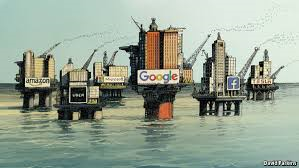The exact day that Data became the New Oil
Jaspreet Bindra
Last week two very significant earth-shaking events (other than the continuing pandemic) took place, both almost on the same day. One was the plummeting of oil prices, where the Brent Crude Oil price (mostly OPEC driven) as well as the West Texas Intermediate price (mostly American shale driven) touched new lows. The WTI nosedived to negative territory, where producers were paying you to take their oil! The other was the announcement that data and social networking behemoth, Facebook, was buying nearly 10% of Reliance, the oil-cum-telecom major.
While both announcements might seem unrelated, I believe that they signal a single watershed moment. Mathematician Clive Humby said in 2006 that that ‘data is the new oil’,A few decades from now, as historians look back, perhaps this is the day that it happened – data became the new oil. Oil plunged, data soared.
Why is the Facebook- Reliance Jio marriage so significant? The answer lies in the new Golden Quadrilateral. Indian readers of this column would be aware of the original Golden Quadrilateral – Vajpayee’s ambitious project to link the four corners of India through a super-highway network, bringing unprecedented connectivity, prosperity and accessibility to vast pars of the country. That one is done and dusted, and the new Golden Quadrilateral is upon us – its corners being the 4 Cs of Content, Carriage, Customer and Commerce.
Through the past decades, different companies have owned or dominated these individual corners– the TV and studios owned content, the telcos owned carriage, the customer was touched by multiple players, and the Amazons of the world owned Commerce. There have been plays where companies have tried to own two of the Cs – Amazon with commerce and customer, AT&T’s botched acquisition of Time-Warner to dominate carriage and content, etc.
But this is perhaps the first grand move to own all parts of the quadrilateral – Reliance led the oil industry in India for decades, now the combine will rule the new oil.
Content: Jio has been investing in a clutch of content properties over the last few years – from music aggregator Saavn to news company Network 1, and has used them as well as their own content to create vast, free content libraries of movies, films, sports and news. Add the treasure trove of user generated content from Facebook, which includes Instagram, content shared on WhatsApp and Facebook Video, its bids for Cricket rights, and the combine has a content hoard which is unparalleled.
Carriage: Out of nowhere, Jio has become the largest telecom player in India, surpassing Airtel, driving Vodafone Idea to despair and near-bankruptcy, and all the others to oblivion. Jio now touches more than 350mn wireless customers, and its cables are rapidly snaking their way to every household in India. They will thus own the data highways, the streets and even the alleyways connecting every Indian, and other players who want to use them might have to pay a toll tax
Commerce: This is where there is a scope for the maximum disruption. Two large firms, Amazon and Walmart Flipkart, own the nascent, but fast-growing ecommerce industry in India. Having said that, ecommerce is still a couple of percentage of the overall retail industry, the large format stores add another 2-3 percentage points. More than 90% of Indian retail is the small kiranas and the mom-and-pop stores. Each one of these small stores uses WhatsApp or Facebook. The combined strength of Whatsapp, Facebook, the Jio telecom network, JioMart and a UPI payment play is the killer strategy to create a new kind of ecommerce company – a vastly distributed one connecting millions of neighbourhood stores to a billion consumers. In the words of Mukesh Ambani himself, “… JioMart and WhatsApp will empower nearly three crore small Indian kirana shops to digitally transact with every customer in their neighbourhood. This means all of you can order and get faster delivery of day-to-day items from nearby local shops. At the same time, small kiranas can grow their businesses and create new employment opportunities.”
Customer: It is very difficult to ‘own’ a customer, since it is usually the customer that owns you. However, this combine will get as close as possible. Jio, as a telecom provider, has a billing relationship with the customer, which gives direct access, great data and high exit barriers. The buying habits of a billion Indians will be an unrivalled data trove for Facebook’s ravenous advertising engines. If most of the customer’s needs are met – data, shopping, entertainment, food – she is unlikely to go elsewhere much, and firmly become a inhabitant of the Quadrilateral.
Strategically, it is a game-changing play, signaling the ascent of the New Economy of data and content over the old economy of oil and petroleum. The combine still has many questions unanswered – there are still no data sharing agreements, there could be divergence in both players intent and strategy, competition and regulators will not take this lying down, and the Open Internet advocates will actively oppose this. But, what remains the biggest question mark is how the customer will gain and how she will react – be a willing, happy citizen of the new Golden Quadrilateral, or a prisoner in a beautiful Walled Garden?


